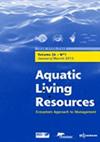海草大型无脊椎动物副产品支持马达加斯加的蚊帐拖网渔业
IF 1.9
4区 农林科学
Q3 FISHERIES
引用次数: 0
摘要
过去20年来,在西印度洋浅层海草床和珊瑚礁中,蚊帐的使用迅速增加,主要用于捕捕小鱼和(或)幼鱼。然而,到目前为止,本地制造的渔具还没有捕获无脊椎动物的报告。2018年8月至2019年2月,通过对渔民的GPS跟踪,研究了马达加斯加西南部托利亚拉湾海草区的蚊帐拖网渔业。通过每月登陆调查监测捕获量,以表征海草床中大型无脊椎动物丰度和多样性的时空格局。渔民们在退潮时进行捕捞,主要是在晚上,他们拉着手工制作的不同尺寸的拖网。总体而言,从109个捕获样本中收集的217,080个个体中鉴定出43个大型无脊椎动物分类群。渔获物主要为甲壳类动物(主要为梭鲈科、梭鲈科、对虾科和梭鲈科)。大型无脊椎动物群落的丰度和生物量以mitsiensis Thalamita为主(分别占总密度和总生物量的6% ~ 100%和5% ~ 100%)。大型无脊椎动物占每次行程总捕获量的1.5%至100%(即4-55公斤行程−1)。它们被出售供人食用或作为动物饲料,这为渔民提供了额外的收入(每次旅行1 - 24美元,每次旅行渔获收入的1 - 72%)。这项研究表明,大型无脊椎动物资源为马达加斯加西南部的小规模渔民提供了宝贵的副渔获物。这种副渔获物产生的收入进一步鼓励使用蚊帐拖网,并加剧了其对沿海海草生态系统和渔业的负面影响。本文章由计算机程序翻译,如有差异,请以英文原文为准。
Seagrass macroinvertebrate bycatches support mosquito net trawl fishery in Madagascar
The use of mosquito nets, primarily for targeting small and/or juvenile fish, has rapidly increased in Western Indian Ocean shallow seagrass beds and coral reefs over the last 20 years. However, to date, invertebrate by-catch by locally-made fishing gear has not been reported. We studied the mosquito net trawl fishery in seagrass areas in the Bay of Toliara, Southwest Madagascar through the GPS tracking of fishers from August 2018 to February 2019. Catches were monitored through monthly landing surveys to characterize spatial temporal patterns in the abundance and diversity of macroinvertebrates in the seagrass beds. Fishing was carried out at low tide, mostly at night, by fishers pulling a hand-made trawl net of varying dimensions. Overall, 43 macroinvertebrate taxa were identified out of 217,080 individuals collected from 109 catch samples. Catches were generally composed of crustaceans (mainly Portunidae, Processidae, Penaeidae, and Alpheidae). The crab Thalamita mitsiensis largely dominated the abundance and biomass of the macroinvertebrate assemblage (from 6% to 100% and from 5 to 100% of the overall density and biomass, respectively). Macroinvertebrates composed 1.5% to 100% of the total catch per trip (i.e., 4–55 kg trip−1). They were sold for human consumption or animal feed, which provided additional income to fishers (USD 1–24 trip−1 and 1–72% of catch income per trip). This study revealed that macroinvertebrate resources provide valuable by-catch to small-scale fishers in Southwest Madagascar. This bycatch generates income that further encourages the use of mosquito net trawls and exacerbates their negative effects on coastal seagrass ecosystems and fisheries.
求助全文
通过发布文献求助,成功后即可免费获取论文全文。
去求助
来源期刊

Aquatic Living Resources
农林科学-海洋与淡水生物学
CiteScore
2.30
自引率
0.00%
发文量
10
审稿时长
>24 weeks
期刊介绍:
Aquatic Living Resources publishes original research papers, review articles and propective notes dealing with all exploited (i.e. fished or farmed) living resources in marine, brackish and freshwater environments.
Priority is given to ecosystem-based approaches to the study of fishery and aquaculture social-ecological systems, including biological, ecological, economic and social dimensions.
Research on the development of interdisciplinary methods and tools which can usefully support the design, implementation and evaluation of alternative management strategies for fisheries and/or aquaculture systems at different scales is particularly welcome by the journal. This includes the exploration of scenarios and strategies for the conservation of aquatic biodiversity and research relating to the development of integrated assessment approaches aimed at ensuring sustainable and high quality uses of aquatic living resources.
 求助内容:
求助内容: 应助结果提醒方式:
应助结果提醒方式:


